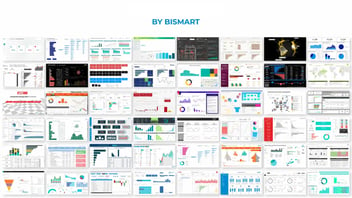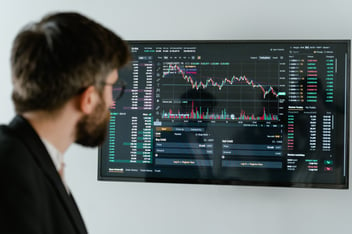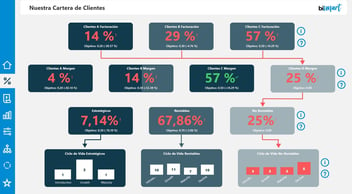We talk about the Next Generation Dashboard, a new-age dashboard that meets today's business information needs. Don't know it yet? Wait no more!
Referring to the dashboard of a car, corporate dashboards were born from the application of mechanical logic to the business world. Just like a car's dashboard, a corporate dashboard monitors business activity. However, business information needs have evolved a lot since the appearance of the first dashboards. We discuss the next generation dashboard.

It is no coincidence that business dashboards are named after vehicles dashboards.
The name dates back to the 1990s when Robert S. Kaplan and David P. Norton published the article «The Balanced Scorecard Measures that Drive Performance» in Harvard Business Review, in which they introduced the Balanced Scorecard for the first time. Kaplan and Norton's approach transformed the way business leaders measured business performance. Before the arrival of this new concept, business leaders only looked at accounting and financial indicators. Kaplan and Norton used the Harvard Business Review article to demonstrate that the analysis methods used by organisations to measure their results had become obsolete and to introduce a new instrument that explored business reality as a whole, including non-financial performance indicators and KPIs, under the principle "if you can't measure it, you can't manage it".
- Download our 'Guide to Evaluate Your Company's Performance and Strategic Plan' and get access to everything you need to know about strategic business planning, the balanced scorecard, performance indicators and KPIs.
Three decades after the Balanced Scorecard revolution, Kaplan and Norton's vision is more than implemented and dashboards have become an imperative for the smooth running of any business. However, business needs have evolved significantly since the publication of that Harvard Business Review article. Executives' information needs have nothing to do with those of the 1990s and the next generation of dashboards must be able to give answers to the information, control and maintenance requirements of the new era.
Many organisations are already starting to work with next-generation dashboards that go beyond simply monitoring business activity by integrating artificial intelligence, machine learning and predictive analytics into dashboards' functionalities.
Next Generation Dashboard: The Dashboard of the Present
A next generation dashboard is a dashboard that takes advantage of new technological capabilities to solve today's business problems and meet the information and control needs of contemporary organisations.
Such dashboards include superior analytical capabilities, particularly relying on real-time and predictive analytics.
Next generation dashboards get to the heart of Big Data, managing vast amounts of data to find the information needed to provide a strategic view of business reality. While dashboards typically illustrate performance indicators, executive decision-makers increasingly need to dig deeper through discovery capabilities.
Bismart's dashboards are designed to be the indicated tool for entrepreneurs to make informed strategic decisions in an easy, fast and secure way, by generating knowledge. Our dashboards offer a comprehensive view of the business reality through a top-down approach. In other words, key information is brought to the forefront so that business owners can get a complete picture of the state of their business. Beyond essentials, our dashboards include enquiry dynamics that enable the generation of insights and intelligence so that executives can drill down to the core of their activity, discover the reasons that lie behind the data, make precise searches on specific topics and take their analysis to a higher level.
We are able to respond to the information needs of the organisations of the future. Today's companies depend on the production of real-time intelligence for immediate decision making. Our dashboards automatically update data, insights and performance indicators so that information is up to date at all times and data-driven decisions are not affected by inaccuracies or decontextualisation.
Besides, nowadays, thinking about the past and the present is as important as thinking about the future. A next generation dashboard should enable data analysts and decision-makers to query historical data and compare time periods. However, the application of artificial intelligence to provide dashboards with predictive analytics capabilities is becoming more and more common. Our dashboards use forecasting so that companies can make decisions based on future trends, optimise their planning and courses of action, react quickly to changes, identify and solve problems before they happen and foresee where business opportunities lie.
The next generation dashboard also integrates with machine learning platforms for improved efficiency.
Next Generation Dashboard: Capabilities and functions
As experts in the development of business intelligence solutions and a Microsoft Power BI partner company, Bismart promotes the development and creation of dashboards that meet the specific and advanced needs of the new era of business knowledge. In this sense, all our dashboards and BI solutions meet the following criteria:
- Global solution: Our dashboards are implemented together with a complete portfolio of services that include all the necessary measures and actions to ensure the tool's proper implementation, cohesion, use and maintenance.
- Usability: Our dashboards apply the most efficient design criteria and ensure optimal usability so that any member of a company can consult, navigate, perform in-depth searches, draw conclusions and make decisions based on the dashboard.
- Business data model: Data models in business terms: Nowadays, data models are no longer competence of technical professional profiles and any user should be able to use them to carry out analysis or create reports. With this objective in mind, our methodology and approach ensure that data model elements (dimensions, tables, indicators, measures, results...) speak in business terms.
- Top-down approach: The design and performance of our dashboards are designed so that, at first instance you can monitor and analyse the most relevant facts of the business activity, enabling you to carry out in-depth analyses with a diagnostic purpose later on.
- Real-time intelligence: Our dashboards automatically update data inputs and results to facilitate real-time decision making.
- They also incorporate an alarm system that alert users in case of abnormal results or important events.
- Predictive analytics: Our dashboards integrate predictive analytics and have the ability to report on future trends in business performance. This allows senior business leaders to anticipate potential problems and take preventive actions.
- They have the ability to integrate non-computerised data such as business objectives or budgets.
The complexity of today's business ecosystem makes it necessary for dashboards to include new functionalities and capabilities. By modelling data in business terms, the top-down approach, automatic updates and the incorporation of artificial intelligence, the next generation dashboard is able to meet the business needs of the new era.
As Kaplan and Norton noted in the 1990s, "if you can't measure it, you can't manage it". Rephrasing the saying to adapt it to the new times, "if you can't measure it now, you can't manage it later".
Haven't downloaded our 'Guide to Evaluate Your Company's Performance and Strategic Plan' yet? Do it now!



